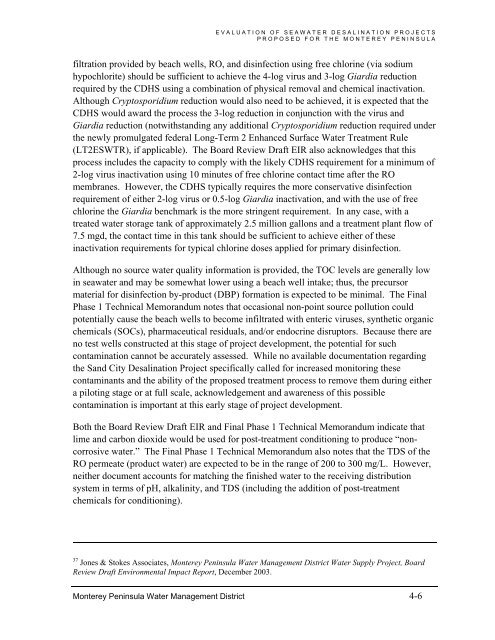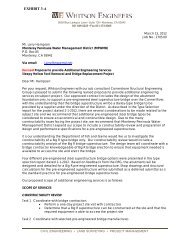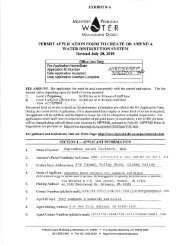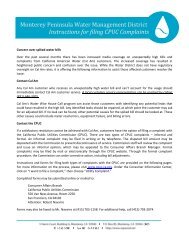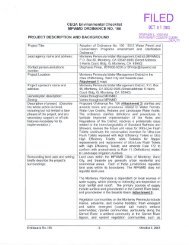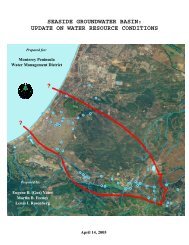FINAL REPORT Evaluation of Seawater Desalination Projects ...
FINAL REPORT Evaluation of Seawater Desalination Projects ...
FINAL REPORT Evaluation of Seawater Desalination Projects ...
You also want an ePaper? Increase the reach of your titles
YUMPU automatically turns print PDFs into web optimized ePapers that Google loves.
EVALUATION OF SEAWATER DESALINATION PROJECTS<br />
PROPOSED FOR THE MONTEREY PENINSULA<br />
filtration provided by beach wells, RO, and disinfection using free chlorine (via sodium<br />
hypochlorite) should be sufficient to achieve the 4-log virus and 3-log Giardia reduction<br />
required by the CDHS using a combination <strong>of</strong> physical removal and chemical inactivation.<br />
Although Cryptosporidium reduction would also need to be achieved, it is expected that the<br />
CDHS would award the process the 3-log reduction in conjunction with the virus and<br />
Giardia reduction (notwithstanding any additional Cryptosporidium reduction required under<br />
the newly promulgated federal Long-Term 2 Enhanced Surface Water Treatment Rule<br />
(LT2ESWTR), if applicable). The Board Review Draft EIR also acknowledges that this<br />
process includes the capacity to comply with the likely CDHS requirement for a minimum <strong>of</strong><br />
2-log virus inactivation using 10 minutes <strong>of</strong> free chlorine contact time after the RO<br />
membranes. However, the CDHS typically requires the more conservative disinfection<br />
requirement <strong>of</strong> either 2-log virus or 0.5-log Giardia inactivation, and with the use <strong>of</strong> free<br />
chlorine the Giardia benchmark is the more stringent requirement. In any case, with a<br />
treated water storage tank <strong>of</strong> approximately 2.5 million gallons and a treatment plant flow <strong>of</strong><br />
7.5 mgd, the contact time in this tank should be sufficient to achieve either <strong>of</strong> these<br />
inactivation requirements for typical chlorine doses applied for primary disinfection.<br />
Although no source water quality information is provided, the TOC levels are generally low<br />
in seawater and may be somewhat lower using a beach well intake; thus, the precursor<br />
material for disinfection by-product (DBP) formation is expected to be minimal. The Final<br />
Phase 1 Technical Memorandum notes that occasional non-point source pollution could<br />
potentially cause the beach wells to become infiltrated with enteric viruses, synthetic organic<br />
chemicals (SOCs), pharmaceutical residuals, and/or endocrine disruptors. Because there are<br />
no test wells constructed at this stage <strong>of</strong> project development, the potential for such<br />
contamination cannot be accurately assessed. While no available documentation regarding<br />
the Sand City <strong>Desalination</strong> Project specifically called for increased monitoring these<br />
contaminants and the ability <strong>of</strong> the proposed treatment process to remove them during either<br />
a piloting stage or at full scale, acknowledgement and awareness <strong>of</strong> this possible<br />
contamination is important at this early stage <strong>of</strong> project development.<br />
Both the Board Review Draft EIR and Final Phase 1 Technical Memorandum indicate that<br />
lime and carbon dioxide would be used for post-treatment conditioning to produce “noncorrosive<br />
water.” The Final Phase 1 Technical Memorandum also notes that the TDS <strong>of</strong> the<br />
RO permeate (product water) are expected to be in the range <strong>of</strong> 200 to 300 mg/L. However,<br />
neither document accounts for matching the finished water to the receiving distribution<br />
system in terms <strong>of</strong> pH, alkalinity, and TDS (including the addition <strong>of</strong> post-treatment<br />
chemicals for conditioning).<br />
37 Jones & Stokes Associates, Monterey Peninsula Water Management District Water Supply Project, Board<br />
Review Draft Environmental Impact Report, December 2003.<br />
Monterey Peninsula Water Management District 4-6


